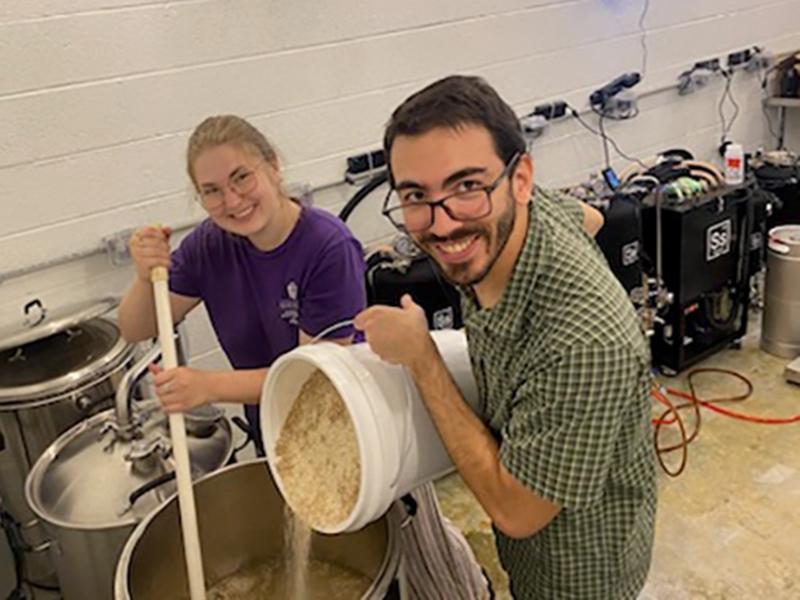
U of A students in multiple disciplines presented beers they crafted in a new brewing course last fall, "BREW 4573/5573 Beer Production and Analysis," and presented them at the end of the semester.
The students, taught by assistant professor of food chemistry Scott Lafontaine in the Department of Food Science, discussed how they designed, produced and analyzed their beers. The goal of the course was for students to pick a style from the style guidelines outlined by the Brewer's Association, develop a recipe, brew the recipe in the U of A Beverage Development Facility and then analyze the beer produced to see how closely they came to the end targets they expected.
These guidelines encompass alcohol by volume, color ranges and bitterness.
"The presented beers truly highlighted the different levers and tools brewers have at their disposal," said Lafontaine, a faculty member in the Dale Bumpers College of Agricultural, Food and Life Sciences and a researcher and scientist with the Arkansas Agricultural Experiment Station, the research arm of the U of A System Division of Agriculture. "Thanks to support from Brewer's Supply Group and HopSteiner, we had excellent raw materials to design and innovate with, and the students did an amazing job."
The students created the following beers:
- IPA (dry-hopped with Canadian red bind harvested at the Fruit Research Station in Clarksville) and an IPA with Citra (Bernardo Guimaraes, Ph.D. student, food science)
- Oatmeal Stout, "Roasted Revelry Stout" (Larissa Morley, horticulture)
- American-Adjunct Lager (with ARoma 22 rice developed at the U of A), "Southern Sipper" (Matthew Aitkens, microbiology)
- Berliner Weisse style, "Berliner Bliss" (Spencer Cullins, food science)
"Spencer made a Berliner Weisse, where she kettle-soured a beer for 24 hours using lactic acid bacteria, similar to the process of making yogurt," Lafontaine said. "Then, it was boiled and fermented. Matthew crafted an American-Adjunct Lager with ARoma 22 rice. Bernardo delved into the aroma quality of red bine hops, grown at the (fruit research) experiment station in Clarksville. Larissa brewed an oatmeal stout to investigate the impact of a hot mash on the mouthfeel of the beer. During the event, they shared what they learned and how they designed, brewed and analyzed their beers."
Some of the students are enrolled in the Certificate of Proficiency in Brewing Science program, housed in Bumpers College. The certificate program includes Beer Production and Analysis as a major requirement. The certificate program is designed for current U of A students or industry professionals interested in a theoretical and practical introduction to brewing and fermentation. It prepares them for careers in brewing, operations, packing, quality control, distribution and more. The program requires 15 hours of coursework and an internship in the brewing industry for direct experience.
About the Dale Bumpers College of Agricultural, Food and Life Sciences: Bumpers College provides life-changing opportunities to position and prepare graduates who will be leaders in the businesses associated with foods, family, the environment, agriculture, sustainability and human quality of life; and who will be first-choice candidates of employers looking for leaders, innovators, policy makers and entrepreneurs. The college is named for Dale Bumpers, former Arkansas governor and longtime U.S. senator who made the state prominent in national and international agriculture. For more information about Bumpers College, visit our website, and follow us on Twitter at @BumpersCollege and Instagram at BumpersCollege.
About the University of Arkansas: As Arkansas' flagship institution, the U of A provides an internationally competitive education in more than 200 academic programs. Founded in 1871, the U of A contributes more than $2.2 billion to Arkansas' economy through the teaching of new knowledge and skills, entrepreneurship and job development, discovery through research and creative activity while also providing training for professional disciplines. The Carnegie Foundation classifies the U of A among the few U.S. colleges and universities with the highest level of research activity. U.S. News & World Report ranks the U of A among the top public universities in the nation. See how the U of A works to build a better world at Arkansas Research and Economic Development News.
Topics
Contacts
Robby Edwards, director of communications
Dale Bumpers College of Agricultural, Food and Life Sciences
479-530-4680, robbye@uark.edu